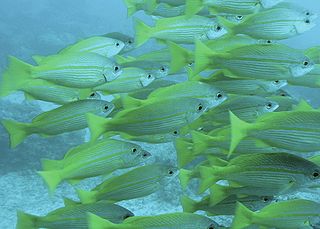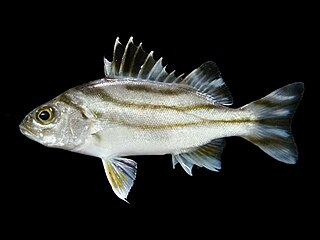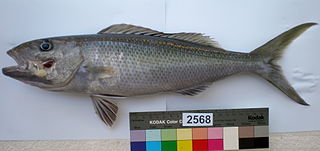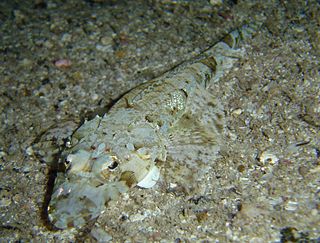
Acropomatidae is a family of fish in the order Perciformes, commonly known as lanternbellies. Acropoma species are notable for having light-emitting organs along their undersides. They are found in all temperate and tropical oceans, usually at depths of several hundred meters. There are about 32 species in as many as 9 genera, although some authorities recognise fewer genera than Fishbase does.

Mycteroperca is a genus of marine ray-finned fish, groupers from the subfamily Epinephelinae, part of the family Serranidae, which also includes the anthias and sea basses. They are predatory fish, largely associated with reefs and are found in tropical and subtropical seas in the Atlantic Ocean and the eastern Pacific Ocean. They are important target species for fisheries.

Plectropomus, commonly known as the coral groupers, is a genus of marine ray-finned fish, groupers from the subfamily Epinephelinae, part of the family Serranidae, which also includes the anthias and sea basses. They are found in the Indo-Pacific region.

The bigeye snapper, also known as the bigeye seaperch, red sea lined snapper, golden striped snapper, rosy snapper, yellow snapper, or simply snapper, is a species of marine ray-finned fish, a snapper belonging to the family Lutjanidae. It is native to the Indian Ocean and the western Pacific Ocean. It is the type species of the genus Lutjanus.

Caesionidae, the fusiliers, are a family of marine ray-finned fishes in the order Perciformes. The family includes about 23 species. They are related to the snappers, but adapted for feeding on plankton, rather than on larger prey. They are found at reefs in the Indo-Pacific and in the Red Sea.

Terapon jarbua, the jarbua terapon, crescent grunter, crescent banded grunter, crescent perch, spiky trumpeter, thornfish or tiger perch, is a species of ray-finned fish, a grunter of the family Terapontidae. It occurs in the Indo-Pacific. it is an important commercial species within its range and is sometimes found in the aquarium trade where it is known as "target fish" for the pattern visible from above.

The whitespot hawkfish, the halfspotted hawkfish, multicolored hand-fish and ornate hawkfish, is a species of marine ray-finned fish, a hawkfish belonging to the family Cirrhitidae. It is found in the Indo-Pacific region.

The green jobfish, also known as the gray jobfish, gray snapper, or slender snapper, and in Hawaiian as uku, is a species of marine ray-finned fish, a snapper belonging to the family Lutjanidae. It is found in the Indo-Pacific region. This species inhabits various reef environments at depths from near the surface to 120 metres (390 ft). It is a very important species for local commercial fisheries and is popular as a game fish, though it has been reported to cause ciguatera poisoning. It can also be found in the aquarium trade. This species is the only known member of its genus.

The false scorpionfish, also known as prettyfins, is a species of perciform fish, the only species in genus Centrogenys, which in turn is the only genus in the family Centrogenyidae. They are pale grey or brown and usually grow no longer than 25 cm (9.8 in). False scorpionfish are distributed throughout the Indo-West Pacific, bounded by the Ryukyu Islands of Japan to the north and Australia to the south, the Nicobar Islands to the west and New Guinea to the east.

The dark-banded fusilier, also known as blue-streak fusilier, bluedash fusilier, or neon fusilier, is a species of marine ray-finned fish, a fusilier belonging to the family Caesionidae. It has a wide Indo-West Pacific range. It is of some importance to fisheries within its range.

Zanclorhynchus spinifer, also known as the Antarctic horsefish or spiny horsefish, is a species of marine ray-finned fish belonging to the family Congiopodidae, the horsefishes or pigfishes. This fish is found in the Southern Ocean where it occurs at depths of from 5 to 400 metres. This species grows to a length of 40 centimetres (16 in) TL and is of minor importance to the commercial fishery industry.

Cymbacephalus is a genus of marine ray-finned fishes belonging to the family Platycephalidae, the flatheads. These fishes are found in the Indo-Pacific region.

The dwarf flathead is a species of marine ray-finned fish belonging to the family Platycephalidae, the flatheads. It is found in the Indo-Pacific. It is the only species in the monotypic genus Elates.

Acropoma is a genus of fish in the family Acropomatidae, the temperate ocean-basses or lanternbellies. They are native to the Indian Ocean and western Pacific Ocean. They are characterized by a ventral luminous organ that has a luminous gland, a lens, and a reflector. The shape of the luminous organ helps distinguish the species in the genus.

The slender fusilier is a species of marine ray-finned fish, a fusilier belonging to the family Caesionidae. It is native to tropical reefs in the Indian Ocean and the western Pacific Ocean, It is of minor importance to local commercial fisheries. This species is the only known member of its genus.

Caesio caerulaurea, the blue and gold fusilier, blue fusilier, gold-band fusilier or scissor-tailed fusilier, is a species of marine fish in the family Caesionidae. It is widespread throughout the tropical waters of the Indo-Pacific area, including the Red Sea.

Pristipomoides sieboldii, the lavender jobfish, lavender snapper or von Siebold’s snapper, is a species of ray-finned fish, which is a snapper belonging to the family Lutjanidae. It is found in the Indian and Pacific Oceans.

Pomadasys argenteus, the silver grunt, silver javelin, grunter bream, small-spotted grunter-bream, small-spotted javelin fish, trumpeter or white-finned javelin fish, is a species of marine ray-finned fish, a grunt from the family Haemulidae. This species has a wide Indo-Pacific distribution. It is the type species of the genus Pomadasys.

Etelis carbunculus, the deep-water red snapper, ruby snapper or longtail snapper, is a species of ray-finned fish, a snapper belonging to the family Lutjanidae. It is found in the Indo-Pacific region.
Pterygotrigla multiocellata, the antrorse spined gurnard, is a species of ray-finned fish belonging to the family Triglidae, the gurnards and sea robins. This fish is found in the Indo-Pacific region where it has been recorded from Japan, Saipan, and the eastern and western tropical waters off Australia.




















